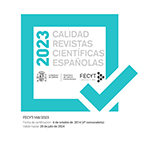El travestismo estratégico como recurso de negociación intercultural en contextos bélicos
Resumen
La adaptabilidad intercultural como recurso para afianzar la colaboración y alianza entre grupos culturalmente distintos es un elemento que sobresale por su eficacia en la conformación de contingentes multinacionales. Sin embargo, históricamente esta situación se ha manifestado mediante procedimientos que hoy no se dan a causa de la uniformización reglamentaria de los ejércitos. Así, el travestismo estratégico como recurso eficaz para generar nuevas formas de representación colectiva en situaciones de conflicto bélico y cultural es un fenómeno performativo que ha servido en algunos contextos para refrendar el compromiso de las alianzas como parte de una diplomacia intercultural. A partir de un análisis comparativo de tres casos históricos (Lawrence de Arabia, Alejandro Magno y Napoleón Bonaparte), se analiza su aplicación y resultado de acuerdo con el grado de compromiso xenófilo y acercamiento integrador que desarrollaron sus protagonistas. Los resultados muestran que la adopción de rasgos que definen la apariencia del otro desde una actitud integradora ayuda a establecer una transidentidad compartida que promueve la colaboración. No obstante, el logro de la implicación del otro en un plano de valoración mutua no impide que dentro del propio grupo cultural surjan resistencias al ver en ese travestismo una amenaza a la integridad y unidad cultural. Por contra, en contextos donde se hace uso del travestismo estratégico sin abandonar una actitud xenófoba o una postura colonialista, el otro grupo considera esta aparente adaptación performativa como una simulación o engaño que acentúa el conflicto.
Descargas
Descarga artículo
Licencia
La revista Política y Sociedad, para fomentar el intercambio global del conocimiento, facilita el acceso sin restricciones a sus contenidos desde el momento de su publicación en la presente edición electrónica, y por eso es una revista de acceso abierto. Los originales publicados en esta revista son propiedad de la Universidad Complutense de Madrid y es obligatorio citar su procedencia en cualquier reproducción total o parcial. Todos los contenidos se distribuyen bajo una licencia de uso y distribución Creative Commons Reconocimiento 4.0 (CC BY 4.0). Esta circunstancia ha de hacerse constar expresamente de esta forma cuando sea necesario. Puede consultar la versión informativa y el texto legal de la licencia.











